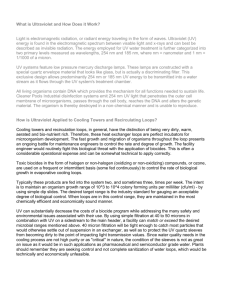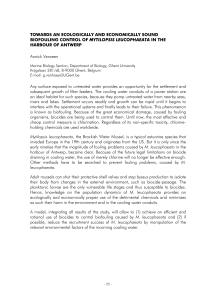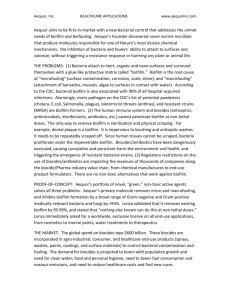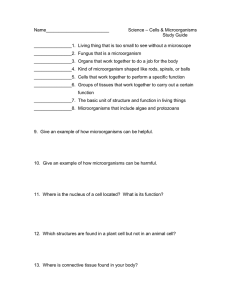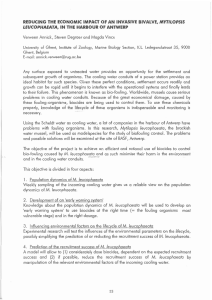Kathon WT--Technical Data Sheet
advertisement
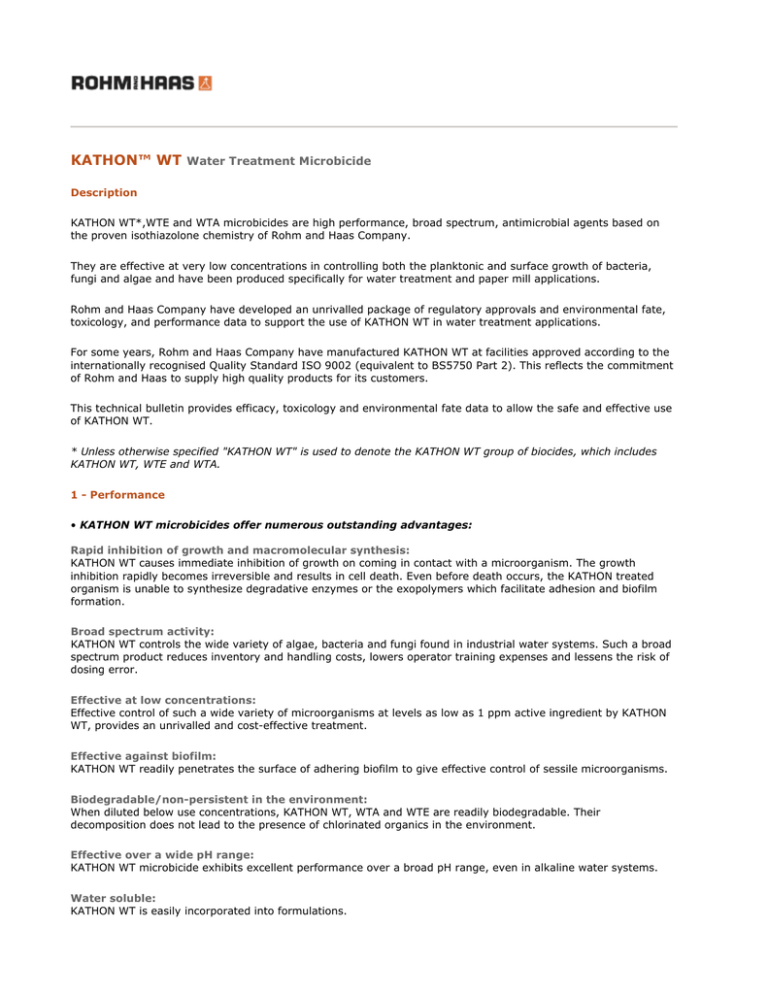
KATHON™ WT Water Treatment Microbicide Description KATHON WT*,WTE and WTA microbicides are high performance, broad spectrum, antimicrobial agents based on the proven isothiazolone chemistry of Rohm and Haas Company. They are effective at very low concentrations in controlling both the planktonic and surface growth of bacteria, fungi and algae and have been produced specifically for water treatment and paper mill applications. Rohm and Haas Company have developed an unrivalled package of regulatory approvals and environmental fate, toxicology, and performance data to support the use of KATHON WT in water treatment applications. For some years, Rohm and Haas Company have manufactured KATHON WT at facilities approved according to the internationally recognised Quality Standard ISO 9002 (equivalent to BS5750 Part 2). This reflects the commitment of Rohm and Haas to supply high quality products for its customers. This technical bulletin provides efficacy, toxicology and environmental fate data to allow the safe and effective use of KATHON WT. * Unless otherwise specified "KATHON WT" is used to denote the KATHON WT group of biocides, which includes KATHON WT, WTE and WTA. 1 - Performance • KATHON WT microbicides offer numerous outstanding advantages: Rapid inhibition of growth and macromolecular synthesis: KATHON WT causes immediate inhibition of growth on coming in contact with a microorganism. The growth inhibition rapidly becomes irreversible and results in cell death. Even before death occurs, the KATHON treated organism is unable to synthesize degradative enzymes or the exopolymers which facilitate adhesion and biofilm formation. Broad spectrum activity: KATHON WT controls the wide variety of algae, bacteria and fungi found in industrial water systems. Such a broad spectrum product reduces inventory and handling costs, lowers operator training expenses and lessens the risk of dosing error. Effective at low concentrations: Effective control of such a wide variety of microorganisms at levels as low as 1 ppm active ingredient by KATHON WT, provides an unrivalled and cost-effective treatment. Effective against biofilm: KATHON WT readily penetrates the surface of adhering biofilm to give effective control of sessile microorganisms. Biodegradable/non-persistent in the environment: When diluted below use concentrations, KATHON WT, WTA and WTE are readily biodegradable. Their decomposition does not lead to the presence of chlorinated organics in the environment. Effective over a wide pH range: KATHON WT microbicide exhibits excellent performance over a broad pH range, even in alkaline water systems. Water soluble: KATHON WT is easily incorporated into formulations. Compatibility: KATHON WT is compatible with chlorine, corrosion and scale inhibitors and most anionic, cationic and non-ionic formulations at normal use levels. Non-surface active: KATHON WT is non-foaming. Infrequent dosing: KATHON WT remains active for long periods of time in the water system, resulting in low service costs. Easily deactivated: Spills of the concentrated active components of KATHON WT are readily deactivated to non-toxic substances by the addition of a slightly acidic solution of sodium metabisulphite or sodium bisulphite. Low toxicity: Extensive toxicological testing has shown KATHON microbicides to be of low toxicity at recommended use levels. Continued testing ensures that potential risks are well defined. 2 - Chemical and Physical Properties • The active ingredient of KATHON WT biocides is a mixture of two isothiazolones identified by the IUPAC system of nomenclature as: The chemical composition, physical and chemical properties of KATHON WT, KATHON WTA and KATHON WTE microbicides are shown in Table 1. Table 1 - Composition and properties of KATHON WT microbicides (these values do not constitute specifications) KATHON WT KATHON WTA KATHON WTE 13.9% 1.5% 1.5% ▪5-chloro-2 methyl-4-isothiazolin-3-one ▪2-methyl-4-isothiazolin-3-one Typical value active ingredients Inert Ingredients 28.0% Water to 100% 3.0% 3.0% to 100% to 100% Typical properties Appearance Clear to slightly hazy liquid Colour Amber-gold Pale yellow Pale yellow green Odour Mild Mild Mild Specific gravity (20°C) 1.32 1.02 1.02 pH (as supplied) 2-4 3-5 3-5 Viscosity (cps) 15°C 25°C 35°C 19.0 16.0 14.5 19.0 16.0 14.5 19.0 19.0 19.0 3 - Stability/Compatibility • KATHON is stable over the wide range of conditions found in cooling water and paper mill applications. Product as supplied: KATHON WT and WTE microbicides are stable as supplied for at least a year at ambient temperatures and for 6 months at 50°C. We recommend, however, that KATHON WTA is stored at 25°C or below for a maximum period of 6 months. Generally, storage conditions appropriate for industrial chemicals should be employed, avoiding exposure to extremes of temperature. At use levels: The performance of biocides in industrial water systems is dependent on their stability. Several factors can influence the rate of degradation including water hardness, pH and temperature. The stability of KATHON WT is actually enhanced in hard water conditions. At normal use levels in water treatment systems, KATHON WT biocides are biologically and physically compatible with: • anionic, cationic and non-ionic surfactants • corrosion and scale inhibitors • chlorine (Table 2) • majority of standard paper mill additives. Figure 1 shows the excellent stability of KATHON WT compared with competitive biocides at different levels of pH, temperature and total water hardness. This is dealt with in greater detail in the section on stability/ compatibility. In addition to its excellent stability at use levels, KATHON WT has the advantage that, when diluted well below its use level, it is readily biodegradable. Table 2 - Stability of 10 ppm active ingredient KATHON WT in the presence of 1.0 ppm free residual chlorine TIME (hours) FREE CHLORINE (ppm) KATHON WT (ppm AI) 0 1.0 10.0 2 1.0 10.0 4 1.0 9.7 6 1.0 9.8 69 0.1 9.1 Temperature: 27°C ; pH 7.5. Fig. 1: Stability of KATHON WT vs. competitive biocides at different levels of temperature and water hardness over a pH range 5.5-9.5 * Total Water Hardness DBNPA = 2.2-dibromo-3-nitrilopropionamide GLUT = glutaraldehyde MBT = methylene (bis) thiocyanate (data not yet available at pH 5.5) 4 - Antimicrobial Properties • KATHON WT is an extremely effective, broad spectrum microbicide which causes an immediate inhibition of growth on coming in contact with a microorganism. KATHON WT rapidly interacts with proteins within the cell, causing an inhibition of respiration and ATP synthesis, which results in an inability to synthesize biopolymers or catabolize substrate. Growth inhibition rapidly becomes irreversible and results in cell death as essential proteins are progressively oxidized. Even before cell death occurs, the KATHON-treated organisms are unable to synthesize either biodegradative enzymes or the exopolymers which facilitate microbial adhesion and biofilm formation. Minimum inhibitory concentrations Tables 3-6 show the minimum inhibitory concentrations (MIC) of KATHON WT active ingredient against microorganisms in test-tube and microtitre plate assays i.e. the lowest concentration which will inhibit microbial growth. This data demonstrates broad spectrum activity against all types of fouling microorganisms e.g. fungi, bacteria, and algae. The methods used to obtain this data are useful for screening antimicrobial substances under standardized laboratory conditions, in nutrient rich growth media. Therefore the effective levels of active ingredient derived from these tests do not necessarily translate into the most efficacious use levels for particular applications. Antimicrobial properties of a water treatment biocide Many water treatment biocides have "gaps" in their activity spectra i.e. they may be good fungicides but poor algicides or bactericides. One biocide which can perform the function of two or three different products, saves both time and money and reduces the chances of dosing errors. A broad spectrum biocide, such as KATHON WT, which prevents the growth of, or kills organisms causing surface fouling, at low concentrations, is essential in industrial water treatment. Table 3 - Minimum inhibitory concentrations of KATHON WT vs fungi a ORGANISM *Aspergillus foetidus *Aspergillus niger *Aspergillus oryzae Candida albican (yeast) Chaetomium globosum *Cladosporium resinae (Hormoconis resinae) Gliocladium fimbriatum Lentinus lepideus Gloeophyllum trabeum ATCC N° ACTIVE INGREDIENT (ppm) 16878 8 9642 9 10196 5 11651 5 6205 9 11274 5 QM7638 9 12653 4 11539 6 R and HL5-83 5 >*Penicillium funiculosum 9644 5 >*Penicillium variabile (glaucum) USDA 2 12569 2 9348 5 10404 5 9449 2 Saccharomyces cerevisiae (yeast) 2601 2 Trichophyton mentagrophytes (interdigitale) 9533 5 *Mucor rouxii Phoma herbarum (pigmentivora) *Aureobasidium pullulans *Rhizopus stolonifer > Rhodotorula rubra (yeast) Table 4 - Minimum inhibitory concentrations of KATHON WT vs bacteriaa ORGANISM ATCC N° ACTIVE INGREDIENT (ppm) 4335 2 8750 2 12837 5 3906 5 11229 8 GRAM-NEGATIVE Achromobacter parvulus *Alcaligenes faecalis Azotobacter vinelandii *Enterobacter aerogenes Escherichia coli >*Flavabacterium suaveolens > Nitrobacter agilis *Proteus vulgaris >*Pseudomonas aeruginosa >*Pseudomonas cepacia 958 9 14123 0.1 8427 5 15442 5 Gibraltar 165 0.75 >*Pseudomonas fluorescens 13525 2 >*Pseudomonas oleoverans 8062 5 9292 2 >*Bacillus cereus var. mycoides R and HL5 2 >*Bacillus subtilis R and HB2 2 Shigella sonnei GRAM-POSITIVE Brevibacterium ammoniagenes 6871 2 21399 6 >Sarcina lutea 9341 5 *Staphylococcus aureus 6538 2 155 2 3004 1 Cellulomonas sp. *Staphylococcus epidermidis Streptomyces albus > Microorganisms causing fouling of cooling towers. * Microorganisms associated with slime deposits in paper-making processes. a: The bacteriostatic and fungistatic tests were performed by serially diluting the biocide in trypticase-soy broth followed by a 1:100 inoculation with 24-hour broth cultures of test bacterium or fungal spore suspension (prepared from 7-14 day culture slants washed with 7 mls of deionized water). Minimum inhibitory concentration levels were determined visually after 2 days incubation at 37°C for bacteria and 7 days incubation at 28-30°C or fungi. • Biofilm. A considerable difference exists between the efficacy of a biocide against free-living or planktonic microorganisms and surface-attached or sessile microorganisms. Sessile microorganisms build up on process surfaces that are in continual contact with water, to form biofilms, which may vary from the more obvious slimy or filamentous layers, to discrete deposits barely visible to the naked eye. Biofilms consist of complex populations of sessile microorganisms (including bacteria, fungi, protozoa and algae) inorganic and organic debris bound together by an extracellular microbial adhesive1,2 (Fig. 2). The polysaccharide matrix protects microorganisms against rapid environmental changes, including the addition of many biocides and other water treatment chemicals, making them more difficult to kill than their freeliving counter-parts. Some biocides may also be deactivated by adsorption to organic and/or inorganic debris within the biofilm itself. Not only do surface-attached microorganisms outnumber planktonic populations by several orders of magnitude, but they are also the direct cause of most problems in industrial cooling water systems, air washers and paper mills. These include: Energy loss due to fouling • increased heat transfer resistance • filter blocking • decreasing fluid flow/increasing pressure drop in pipes Microbial-induced corrosion • of unprotected metal surfaces beneath the biofilm Decreased manufacturing efficiency • breakaway biofilm interferes in paper manufacture • increased stoppages for cleaning and maintenance of equipment Failure of other water treatment chemicals • biodegradation of additives such as corrosion inhibitors Potential health effects • biofilm may harbour pathogenic or potentially pathogenic organisms e.g. Legionella and Pseudomonas spp. Table 5 - Minimum inhibitory concentrations of KATHON WT vs algae b ORGANISM ACTIVE INGREDIENT (ppm) CHLOROPHYTA (GREEN ALGAE) >Chlorella oleofaciens >Chlorella pyrenoidosa 0.12 0.03 Scenedesmus quadicauda 1.0 Selenastrum capricornutum 0.25 >Ulothrix fimbriata 0.63 >Ulothrix acuminata 0.63 Table 6 - Minimum inhibitory concentrations of KATHON WT vs blue green bacteria b CYANOPHYTA/CYANOBACTERIA Anabaena flos-aquae 0.03 Nostoc commune 0.12 >Oscillatoria prolifera 0.08 Phormidium luridum 0.12 Synechococcus leopoliensis 0.50 Schizothriz calcicola 0.31 Scytonema hofmanni 0.16 Calothrix parienta 0.31 Microcystis aeruginosa 0.16 > Microorganisms causing fouling of cooling towers. b: A 96-well microtitre plate assay using two-fold serial dilutions in growth media, was employed to determine MIC values against algae and blue green bacteria. Microorganisms used as inoculum were grown up on an algal-cyanobacterial medium under constant agitation and with a 16 hour illumination cycle. MICs were determined visually (using a microtitre plate reader) after 14-21 days incubation at 25°C under constant illumination. • The need for activity against biofilm. An industrial water treatment biocide must be active against biofilm. In spite of this, many biocides are still only tested against planktonic microorganisms (see Cooling Water Microbicide section). Rohm and Haas have been at the forefront of research into sessile testing* and have independently developed and tested two laboratory methods for monitoring the use of biocides to control biofouling in industrial water distribution systems, namely: • model cooling towers • circulating biofilm loops KATHON WT is not only effective in killing microorganisms in existing biofilms, but will also prevent biofilm regrowth when regularly dosed into a clean system. KATHON WT is one of the few microbicides extensively tested against biofilm organisms during its development. A more comprehensive discussion of biofouling, the problems it causes and the efficacy of KATHON WT against biofilms, are given in the Cooling Water and Paper Mill Microbicide sections. * See External Rohm and Haas Publications list at the end of this bulletin. 5 - Comparative Efficacy • Field and laboratory evaluation. KATHON WT has been evaluated against competitive biocides in extensive laboratory tests and field trials. Results show that it easily out-performs its nearest competitors (Fig. 3). It produces excellent control against sessile aerobic and anaerobic microorganisms, in both industrial cooling systems (Fig. 4 and Table 7) and as a paper mill slimicide (Fig. 5). Field trials in an industrial air washer have also proved its excellence as a microbicide (Table 8). It is effective over a wide pH range and is therefore ideal for use in the alkaline conditions that exist in multi-cycle cooling towers and modern papermaking. It is attractive economically because low levels and infrequent doses can be used successfully. Fig. 3 : Comparative efficacy of KATHON WT and alternative water treatment biocides against biofilm in model cooling towers (viable cells per sq cm). The approximate cost of alternative biocide treatment have been calculated in comparison with that of 1 ppm AI KATHON WT and are expressed as costequivalents Fig. 4 : Effect of KATHON WT on naturally occurring microbial populations in an industrial cooling tower Table 7 - Effect of KATHON WT on microbial populations in an industrial cooling tower AREA SAMPLED % REDUCTIONa AFTER: MICROORGANISM INITIAL COUNT Basin Water Bacteria Fungi Algae 1.30 x 106/ml 2.80 x 102/ml 3.93 x 102/ml Slats Bacteria Fungi Algae 2.79 x 109/cm2 1.64 x 105/cm2 3.44 x 105/cm2 Distribution Boxes Bacteria Fungi Algae 4.58 x 1010/cm2 4.19 x 104/cm2 2.06 x 107/cm2 a: % Reduction based on initial count. 3 Weeks Dose 9 ppm AI 5 Weeks Dose 1 ppm AI 5 Weeks Dose 0.5 ppm AI 75 94 96 53 93 88 86 91 – 98 99.5 – 97 94 88 94 99.2 96 99.9 99.4 >99.99 97 93 92 95 93 99.98 Fig. 5 : Comparative efficacy of KATHON WT and carbamate in a paper mill producing newsprint Figure 5 illustrates a case history of biocide treatment in a newsprint mill where biocide addition was at the broke towers. Using carbamate, bacterial counts in the broke pulp were unacceptably high. After changing to a costequivalent level of KATHON WT, bacterial counts in the broke were significantly reduced and downtime due to contamination was minimized. Table 8 - Effect of KATHON WTE on the microbial populations in an industrial air washing system a,b COMMON SUMP AIR WASHERS Total Count /ml Fungi/ml SRB/ml c Total Count /ml Fungi/ml Initial Count (No KATHON WTE) 7.5 x 105 70 6.3 x 102 1.0 x 106 30 7.4 x 102 After 1st dose 3 hours 24 hours 2.2 x 105 6.0 x 103 0d 0 0 9 1.7 x 105 1.0 x 103 0 1 0 0 After 2nd dose 3 hours 24 hours 9.0 x 103 1.0 x 103 8 0 80 0 1.2 x 104 8.0 x 103 0 0 35 0 After 3rd dose 3 hours 7.0 x 103 0 0 1.0 x 103 0 0 SRB/ml c a: System Parameters Volume of water: 945,000 litres Retention time: 2.5 cycles (19 days based on blowdown) pH: 7.6 KATHON WTE level: 1.0 ppm AI Dose schedule: Initial dose: 60.5 litres KATHON WTE charged into common sump (60 ppm as supplied) Subsequent doses: 7.5 litres KATHON WTE 1.5% charged into common sump based on blowdown b: Visual Evaluation KATHON WTE maintained a clean system. No problems of odour or foaming were encountered during or after the trial c: Most probable number of sulphate reducing bacteria/ml d: 0 = none detected 6 - Application Areas • KATHON WT is ideally suited to meet the requirements of an industrial water treatment biocide. KATHON WT microbicide is not deactivated by suspended organic matter, and is compatible with other water treatment additives, including chlorine. With the recent change of many cooling towers and paper mills to alkaline operating conditions, it is important to use a biocide such as KATHON WT, which remains stable at higher pH values. KATHON WT is of low toxicity at use levels, easily deactivated and biodegradable. In addition to all these essential properties, KATHON WT is cost-effective. Table 9 APPLICATIONS MAXIMUM USE LEVEL (ppm active ingredients) 1. Industrial cooling water systems 15.0 2. Industrial air washers with efficient mist-eliminating system 15.0 3. Paper mill slimicides 15.0 • Cooling tower microbicide. KATHON WT is a broad spectrum biocide, active against microorganisms in the biofilm. It is cost-effective and ideally suited for use in todays alkaline, multi-cycle towers (Fig. 4). A concentration of KATHON WT as low as 1 ppm active ingredient, single-dosed every 3-7 days (depending on blowdown rate) is often sufficient to control severe microbiological fouling. • Air washer microbicide. KATHON WT is very effective in controlling microbial growth in industrial air washing systems (Table 8). • Paper mill slimicide. KATHON WT is a high performance paper mill slimicide with a broad spectrum of activity which can cope with the rapid changes in microbial flora that occur in different papermaking systems. It penetrates and kills microorganisms in the biofilm and is not inactivated by the high level of suspended organic solids found in paper mill water. It also provides cost-effective microbial control (Fig. 5). • Maximum use levels. These maximum use levels relate to the level of KATHON WT active ingredients which may be constantly present in the applications described. Lower maximum use levels may be appropriate in some instances to satisfy local environmental discharge/regulatory requirements. For further information on maximum use levels, please refer to the Safety Guidelines Bulletins. 7 - Toxicology and Environmental Fate • Rohm and Haas Company, one of the foremost specialty chemical manufacturers, takes every measure to ensure that its products are safe for both people and the environment. Toxicology In line with this policy, Rohm and Haas provide comprehensive toxicological data for KATHON WT, which shows that it is of low toxicity at use-levels. Environmental fate With the tightening of legislation governing the quality of industrial effluent, a major consideration in the choice of a biocide for industrial water treatment is its fate in the environment. This is discussed in more detail in the section on Environmental Fate and some of the original research is published in the Journal of Agricultural and Food Chemistry, 23, 1060-1075, 1975. Reprints are available on request. • KATHON WT has minimal environmental impact because of the following properties: • • • • • high performance product very low use levels readily biodegradable/non-persistent in the environment does not lead to the presence of chlorinated organics does not affect performance of waste water treatment plants KATHON WT has been shown to be environmentally acceptable by a variety of test procedures. The criteria for acceptability is beyond the most stringent control parameters introduced by regulatory authorities. This unique combination of properties makes KATHON WT a first choice for any water treatment programme. Fig. 7 : Dissipation of KATHON WT AI in river water 8 - Current Regulatory Status • The list below is intended to assist you and your customers to comply with prevailing regulatory controls. It illustrates the status of KATHON WT microbicide in those countries where specific approvals are required. Current regulatory status Other grades of KATHON microbicides based on the same active ingredients as KATHON WT have obtain FDA or BGA approvals allowing their use as preservatives in latex which is employed in the production of adhesives and paper and board for contact with dry, aqueous and fatty foods. For further details of those approvals, please contact your local Rohm and Haas Sales Office. Table 10 COUNTRY PRODUCT REGULATORY CLEARANCE APPLICATION NOTES Germany KATHON WT and WTE Active Ingredient (AI) BGA Rec. XXXVI “Paper and paper board" As slimicide in manufacture of food contact paper As a slimicide at a maximum level of 4 ppm AI in dried fibre Italy KATHON WT and WTE AI Decree August 7, 1987 N° 395 Food contact paper At 0.1 ppm AI max. extractable from paper Netherlands KATHON WT N° 9926 N August, 1985 Paper mill and cooling water slimicide Not for food contact Can be used in manufacture of food contact paper KATHON WTA N° 10034N Sweden KATHON WTE Swedish Chemicals Inspectorate N° 3401 Paper mill slimicide Switzerland KATHON WT and WTE AI EGA Substance List N° 49466 Class III All USA KATHON WT and WTEa EPA 707-128 707-133 Cooling towers and air washers KATHON WTa EPA 707-132 Paper mill slimicide KATHON WT and FDA 21 CFR176. 300 Paper slimicide WTEa AI Up to max. use level of 1.4 lb AI/ton dry wgt. paper a: These products have different designations in the USA. It should be borne in mind that these clearances apply to KATHON microbicides as submitted by Rohm and Haas Company and that formulations containing other ingredients may need to be resubmitted for approval. 9 - References • General. 1. Characklis, W.G. and Cooksey, K.E. (1983). Biofilms and microbial fouling. Adv. Appl. Microbiol., 29, 93-138. 2. Costerton, J.W., Geesey, G.G. and Cheng, K. (1978). How bacteria stick. Sci. Am., 238, 86-96. • External Rohm and Haas publications. • Costerton, J.W. and Lashen, E.S. (1984). Influence of biofilm on efficacy of biocides on corrosion-causing bacteria. Mater. Perform. 23,13-17. • Haack, T.K., Lashen, E.S. and Greenley, D.E. (1988). The evaluation of biocide efficacy against sessile microorganisms. In Developments in Industrial Microbiology, vol. 29. (J. Indust. Micro., Suppl. N° 3) pp. 247-253. • Haack, T.K., Shaw, D.A. and Greenley, D. E. (1986). Isothiazolones preserve starch-based drilling muds. Oil and Gas J., January 6th, 1986. • Krzeminski, S.F., Brackett, C.K. and Fisher, J.D. (1975). Fate of microbicidal 3-isothiazolone compounds in the environment : Modes and rates of dissipation. J. Agric. Food Chem., 23, (6), 1060-1068. • Krzeminski, S.F., Brackett, C.K., Fisher, J.D. and Spinnler, J.F. (1975). Fate of Microbicidal 3-isothiazolone compounds in the environment: Products of degradation. J. Agric. Food Chem., 23, (6), 1068-1075. • McCoy, W.F. and Lashen, E.S. (1985). Biocide efficacy against sessile microorganisms in laboratory model cooling towers. Proc. U.K. Corrosion '85, Harrogate. 259-269. • McCoy, W.F. and Lashen, E.S. (1986). Evaluation of industrial biocides in laboratory model cooling towers. Proc. Ann. Meet Cooling Tower Inst., Paper N° TP-86-17. • McCoy, W.F., Ridge, J.E. and Lashen, E.S. (1986). Kinetic analysis of a new delivery system for cooling towers. Proc. 47th Annual Meeting The International Water Conference, Pittsburg, PA. • McCoy, W.F., Wireman, J.W. and Lashen, E.S., (1986). Efficacy of methyl-chloro/methylisothiazolone biocide against Legionella pneumophila in cooling tower water. J. Indust. Micro., 1, 49-56. • Ruseska, I., Robbins, J., Costerton, J.W. and Lashen, E.S. (1982). Biocide testing against corrosion-causing oilfield bacteria helps control plugging. Oil and Gas J., 253-264. • Tanner, R.S., Haack, T.K., Semet, R.F. and Greenley, D.E. (1985). A mild steel tubular flow system for biofilm monitoring. Proc. U.K. Corrosion '85, Harrogate. pp. 259-269. • Williams, T.M. (1988). Growth and control of biofouling microorganisms in modified laboratory cooling towers. Proc. 2nd Venezuelan Corrosion Conference, Venezuelan Central University, Caracas, Venezuela. Acknowledgements The electron micrograph which forms Figure 2 has been reproduced by kind permission of the Fouling Forum, Harwell Laboratories, U.K. A.E.A. The photograph on page 16 has been reproduced by kind permission of New Thames Paper Company, part of UK Paper, U.K. KATHON is a trademark of Rohm and Haas Company, or of its subsidiaries or affiliates. These suggestions and data are based on information we believe to be reliable. They are offered in good faith, but without guarantee, as conditions and methods of use of our products are beyond our control. We recommend that the prospective user determines the suitability of our materials and suggestions before adopting them on a commercial scale. Suggestions for uses of our products or the inclusion of descriptive material from patents and the citation of specific patents in this publication should not be understood as recommending the use of our products in violation of any patent or as permission or license to use any patents of the Rohm and Haas Company. For further details, please contact your local Account Manager or local Business Representative. ©Rohm and Haas, 2006 All rights reserved. December 2000 BIO.KATHON WT GE.PB. E.
